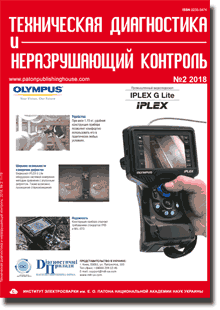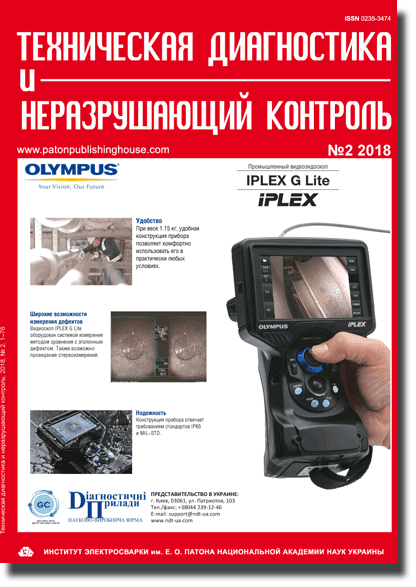| 2018 №02 (05) |
DOI of Article 10.15407/tdnk2018.02.06 |
2018 №02 (07) |

Technical Diagnostics and Non-Destructive Testing №2, 2018, pp. 45-52
Monitoring and calculation of stressed state of underground main gas pipelines in mine working zones
Z.S. Yaskovets, I.V. Orinyak
G.S.Pisarenko Institute for Problems of Strength of the NAS of Ukraine, 2 Timiryazevskaya str., 01014, Kyiv, Ukraine. E-mail: info@ipp.kiev.ua
Abstract:
The work provides a description of the system and results of monitoring stresses in pipelines that are located in the zone of impact of mine workings. Strain measurement was realized using strain gauge resistors, collected into a modified heat-compensated half-bridge Wheatstone circuit. For the purpose of continuous monitoring, the half-bridge circuit is complemented by a system of automatic reading and recording. The locations of mounting the monitoring systems were determined on the basis of predictive calculations of stressed state of gas pipelines under the impact of mine workings. Monitoring results confirmed the correctness of the used computational methods. Moreover, processes of loading and stress relaxation in time were recorded. It is found that loading of an underground gas pipeline during testing of mine working occurs uniformly, both in the compression and tension regions. After passing the mine working, it was recorded that the processes of stress relaxation in the gas pipeline proceed non-uniformly in different regions. In the gas pipeline zones under tension (removed from the mine working center) relaxation runs much faster than in the compressed region (in the mine working center).
Keywords: main pipeline, mine working, stressed state, monitoring, Wheatstone bridge circuit
- Posylny, Yu.V. (2001) Geometry of the trough of the earth’s crust moving over mining operations of coal mines. In: Syn. of Thesis for Cand. of Techn. Sci. Degree. Novocherkassk [in Russian].
- (1988) Instructions for observing the movement of rocks and the earth’s surface during underground mining of ore deposits. Moscow, Nedra [in Russian]. Moscow, Nedra [in Russian].
- Orynyak, I.V., Yaskovets, Z.S. Method of internal response function for assessment of the stressed state of underground main gas pipelines in mining operation zones. Problemy Mitsnosti (in the press 12.02.2018) [in Ukrainian].
- Gusejnov, K.B. (2015) Monitoring of stress-strain state of landslide section of the linear part of the main gas pipelines. Neft, Gaz i Biznes, 41-43 [in Russian].
- GSTU 101.00159226.001-2003 (2004): Rules for working out buildings, structures and natural objects during the extraction of coal underground. Kyiv [in Ukrainian].
- Martin, P. Derby, Marc D. Saunders, Benjamin Zand (2016) Geotechnical instrumentation: Monitoring longitudinal stress of a high pressure pipeline during longwall mining operations – a case study in west Virginia. In: Proc. of Int. Pipeline Conf. IPC2016 (September 26-30, 2016, Calgary, Alberta, Canada).
- (2005) American Lifelines Alliance: Guidelines for the design of buried steel pipe. American Society of Civil Engineers, July 2001 (with addenda through February 2005).
- (2012) ASME B31.8: Gas transmission and distribution piping system, ASME Code of Pressure Piping B3, American Society of Mechanical Engineers.
- (2013) API 1104: Welding of pipelines and related facilities. API, September 2013, 21st Ed.
- Seryoznov, A.N., Shashurin, A.K. (1990) Methods and measurement means in strength experiment. Moscow, Izd-vo MAI [in Russian].
- Precise and flexible strain gauges. Tokyo Sokki Kenkyuio Co., Ltd. www.tml.jp/e
Received: 13.03.2018
Published: 24.05.2018
The cost of subscription/purchase order journals or individual articles
| Journal/Currency | Annual Set | 1 issue printed |
1 issue |
one article |
| TPWJ/USD | 384 $ | 32 $ | 26 $ | 13 $ |
| TPWJ/EUR | 348 € | 29 € | 24 € | 12 € |
| TPWJ/UAH | 7200 UAH | 600 UAH | 600 UAH | 280 UAH |
| AS/UAH | 1800 UAH | 300 UAH | 300 UAH | 150 UAH |
| AS/USD | 192 $ | 32 $ | 26 $ | 13 $ |
| AS/EUR | 180 € | 30 € | 25 € | 12 € |
| SEM/UAH | 1200 UAH | 300 UAH | 300 UAH | 150 UAH |
| SEM/USD | 128 $ | 32 $ | 26 $ | 13 $ |
| SEM/EUR | 120 € | 30 € | 25 € | 12 € |
| TDNK/UAH | 1200 UAH | 300 UAH | 300 UAH | 150 UAH |
| TDNK/USD | 128 $ | 32 $ | 26 $ | 13 $ |
| TDNK/EUR | 120 € | 30 € | 25 € | 15 € |
AS = «Automatic Welding» - 6 issues per year;
TPWJ = «PATON WELDING JOURNAL» - 12 issues per year;
SEM = «Electrometallurgy Today» - 4 issues per year;
TDNK = «Technical Diagnostics and Non-Destructive Testing» - 4 issues per year.





